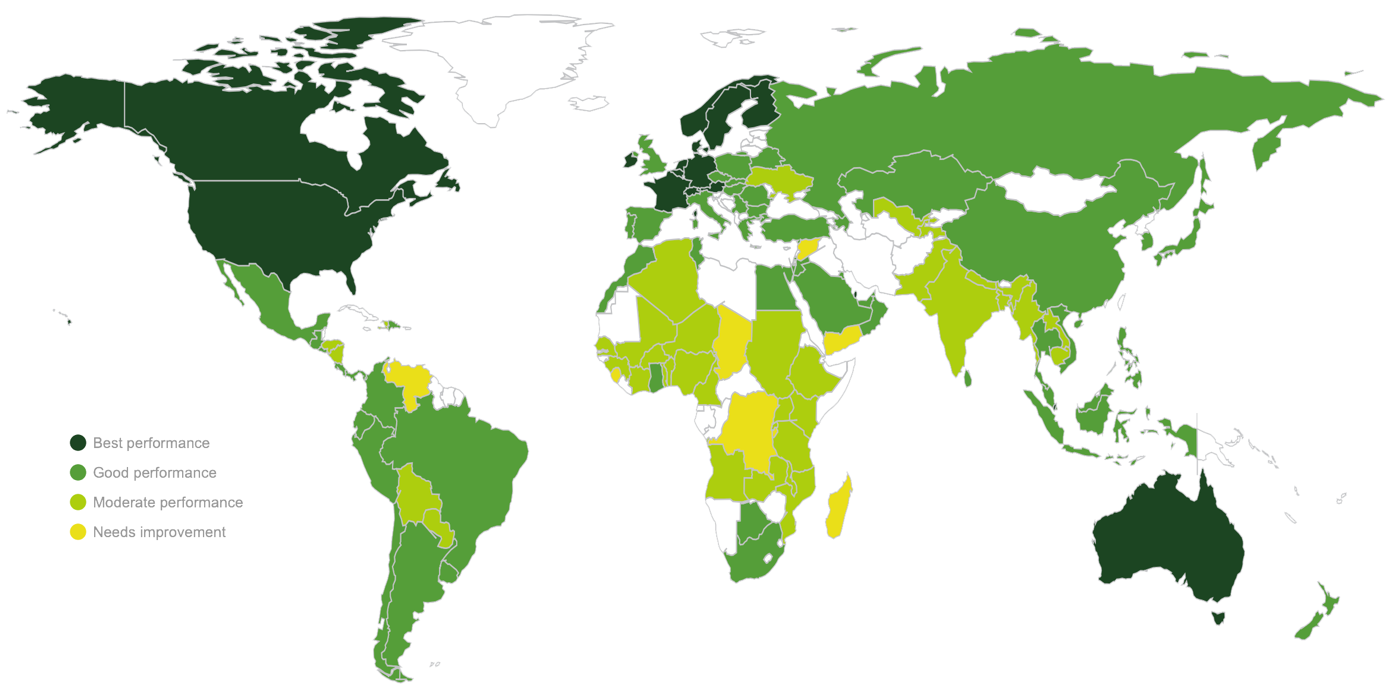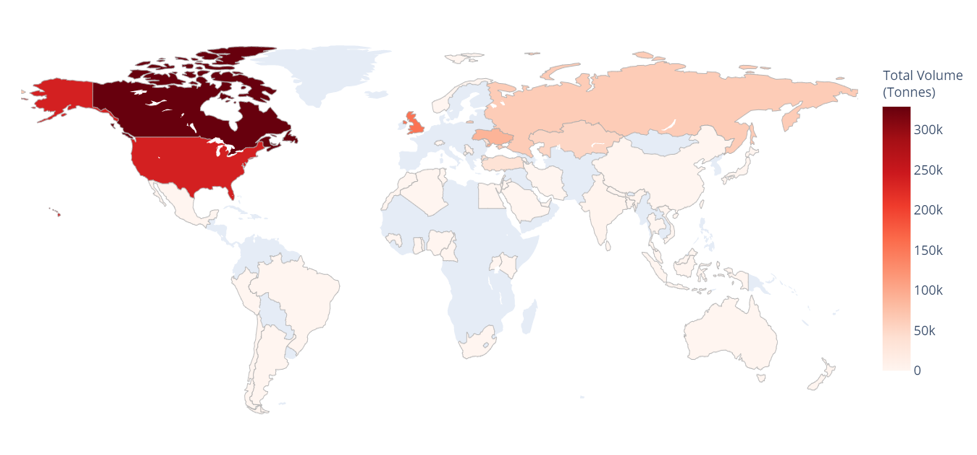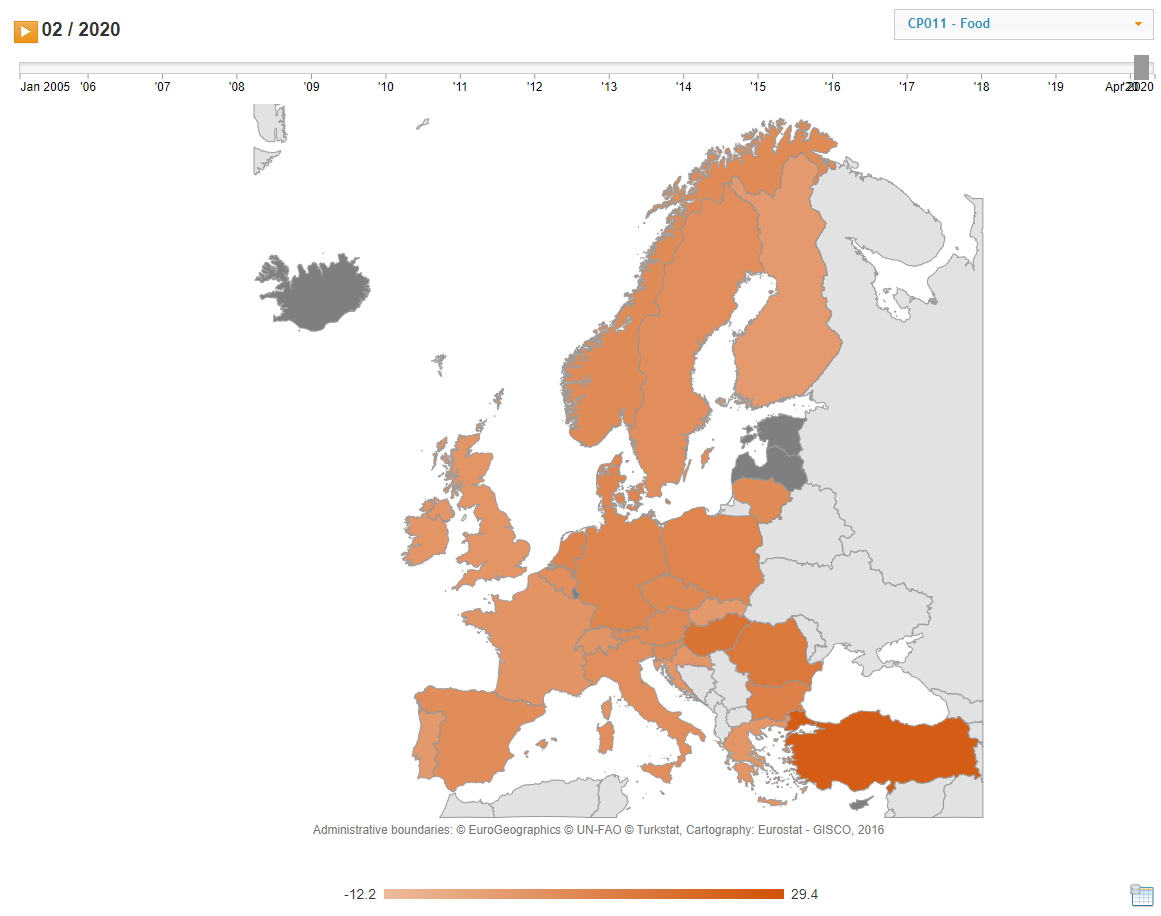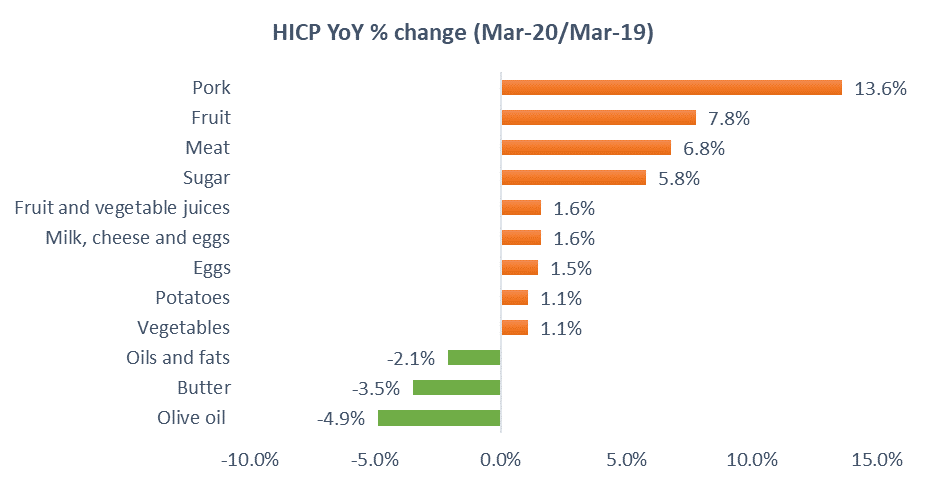Threats to Food Security: Is Another Pandemic Lingering on the Horizon?
Insights into how COVID-19 impacts food security worldwide and the challenges posed.
The global food system currently accounts for 10% of world GDP and employs approximately 1,5 billion people. As the system is increasingly globalised, food produce travels across continents before arriving at destination of consumption. This widespread import and export of foods results from consumers’ desires to pick their foods from various assortments all-year round.
Over the past 30 years, food exports have grown six-fold, with four-fifths of people living in part from calories that were produced in another country. For instance, in Western-European supermarkets one can find Mexican limes, bananas from Costa Rica or potatoes from Israel. With the occurrence of the COVID-19 crisis, it is not surprising that these export mechanisms have been severely disrupted. Consequently, consumers are starting to realise that the widespread availability of products cannot be taken for granted.
The number of people around the world who face issues in food security has fallen from 36% of the world population to 11% between 1970 and 2020. Even though this progress is valuable and the global food system seems to weather COVID-19 in most countries, the pandemic highlights existing inequalities in global food supply, and further grows this divide.
The actual impact of COVID-19 on consumers will become visible over the medium to long run, and food insecurity amongst consumers will worsen. This prediction is based on the significant economic impact and slowdown of economies around the world, which will make authorities of food import-dependent countries struggle to obtain the food products required to sustain their populations. Furthermore, rising unemployment rates will hit their most vulnerable citizens.
To assess how COVID-19 impacts food supply across different continents, we highlight current and imminent challenges in food security to portray the extent of this humanitarian crisis, and elaborate on differences between continents.
Early signs of the food crisis
The inequality in global food distribution have been pressing issues to humanity since long before the pandemic. Despite the fact that world farmers produce a sufficient amount of food to feed 1,5 times of the world population, approximately 820 million people regularly go to bed hungry, of whom 135 million suffer from acute hunger.
The root cause of famine depends on several factors, of which some are man-made, such as conflicts, inefficiency in food distribution, economic crises, and lack of adequate infrastructure, but also natural causes. Moreover, these factors contribute to a worldwide increase in food prices over the past five years, with a more dramatic increase in countries that face strong challenges - such as destructed crops in East Africa caused by the worst locust blight in the past 70 years in January 2020 or the wipe out of one third of the pig population in China due to African swine fever.
Therefore, it is not surprising that COVID-19 magnifies the already existing issues around food security, drawing two starkly different realities between rich and poor countries. For rich countries, the risk of spikes in food prices results in shortages of some of the foods for a period of time. However for poor countries, the amplified impact of COVID-19 on food security signals a looming hunger pandemic.
To illustrate differences between countries, figure 1 visualises the Global Food Security Index, which benchmarks 113 countries based on the affordability, availability, quality and safety of the food, and the exposure to the impacts of climate change.

Figure 1: Screenshot of an interactive overview of the Global Food Security Index, which benchmarks food security performance worldwide as of December 2019
As illustrated by figure 1, countries in North America, Europe and Australia are most secure in terms of food security, while most African countries, as well as Venezuela are more vulnerable and face a serious threat to food security. Therefore, the economic and logistic consequences of COVID-19 echoes more devastatingly in developing countries, causing fear among U.N. officials that hunger may be more deadly than COVID-19 itself.
Key challenges in food supply worldwide
As described above, the existing challenges in food security are amplified as a result of COVID-19. In this part we draw on country examples to illustrate the challenges that COVID-19 poses to sustainable food security worldwide, in terms of changing demands, disruptions in food production, as well as disruptions in supply chains.
Changing demands in food products
One of the first responses of consumers to COVID-19 was a fear of scarcity. As countries were moving towards lockdown, consumers dreaded that their opportunities to buy groceries would be limited. Consequently, consumers engaged in panic buying and hoarded shelf-stable food, such as canned fruits, vegetables and grains, increasing demand for these foods.
This drive towards increased purchases of shelf-stable foods was driven by uncertainty about the future, as consumers avoid the risk of being ‘locked’ at home without sufficient food to sustain themselves and their family. Furthermore, panic buying causes a self-fulfilling prophecy, where consumers increase their purchase levels, and as soon as shelves are starting to look empty, they purchase even more. However, the root cause of empty shelves in Western countries was not scarcity, but the sudden spike in purchases that led to increased stress on the supplier side, as producers struggled to meet demand because of issues in labour and logistics capacity.
Furthermore, supermarket demand for foods that belong to a staying-at-home diet and home-cooking is on the rise and sales of comfort food increase as consumers attempt to feel as comfortable as possible at home. For example, in the United States sales of potato chips rose with 30%, popcorn with about 48% and pretzels with 47% in the week ended March 14, compared to a year earlier.
Though some producers highly profit from adjusted eating behaviours, the other side of the coin is that others struggle with reductions in demand. These reductions are mostly related to “outdoor foods”, as products that are predominantly demanded by hospitality are ordered less due to e.g. closed restaurants and cancelled events.
An example of “outdoor foods” for which sales have decreased is ice cream. For example, ice cream sales in India decreased by almost 50 percent during the lockdown period that started on 24 March. Furthermore, within the EU, a reduction is visible in sales of high-value cut meats, and expensive meats are replaced with cheaper poultry. This effect may not only result from decreased consumption of these foods in hospitality, but also because of the “income effect of demand”, meaning that demand for premium food products decreases as income levels in households reduce or are uncertain.
Moreover, sales of fries came to a stand-still in the foodservice sector due to lockdowns. For instance, some Western countries, such as the Netherlands and Belgium, are large exporters of frozen fries. In the Netherlands, 90 percent of pre-fried potato products are exported to other countries. Of this export, 70 percent is sold in other European markets, and 30 percent is exported to third-country markets such as Saudi Arabia, Brazil, Russia, and Japan. However, as demand is down in all these countries, the Netherlands is left with extensive amounts of left-over potatoes for frozen fries. Belgium copes with the same problems, as 750,000 tons of potatoes may potentially be destroyed during the 2020 season, realising a loss of €125 million. In an attempt to save the frozen fries sector, Belgian consumers were asked to eat fries twice a week instead of once.
Thus, changing demands in food products requires swift adjustments from food producers, either to increase the amount of food they are able to produce to suit demand, or to overcome losses in sales and optimise their offerings to suit the renewed consumers’ desires.
Disruptions in food production
Even if demand for food products is still up, producers may face challenges in terms of disruptions in their food production. The agricultural industry appears to be particularly sensitive to the altered circumstances resulting from COVID-19, as a range of issues arise. These issues concern, amongst other things, a decreased availability of key agricultural inputs such as seeds, fertiliser and pesticides for farmers, but also widespread labour shortages due to sickness and movement restrictions.
In terms of sickness amongst workers, COVID-19 poses a threat to food disruption as labourers on farms or processing plants are at a heightened risk of falling ill, as these labourers work side by side in cramped conditions, and often live in communal housing where social distancing is not attainable.
The impact of COVID-19 is particularly highlighted by the considerable number of outbreaks of COVID-19 amongst employees of meat factories. For example, in the United States, about half of the COVID-19 hotspots as of 15 May 2020 were linked to meat processing plants, where poultry, pigs and cattle are slaughtered and packaged. Consequently, plants had to be temporarily closed, halting meat production. Per illustration, figure 2 visualises the current status of meat plant closures in the United States.

Figure 2: Temporary meat plant closures as of 21 May 2020, as provided by Meat Poultry.
However, the United States is not the only country coping with temporary closings of meat processing plants as this phenomenon occurs worldwide, with hotspots occurring in meat plants in e.g. Ireland, Netherlands, Germany and Canada.
The temporary closure of meat processing plants combined with changing consumer demands caused meat slaughter to fall significantly across the world. For example, figure 3 illustrates how bovine meat slaughter fell in most European countries in February 2020 compared to January 2020. For Europe, the average fall was estimated at -12.3%.

Figure 3. Percentual change in Bovine meat slaughter between January 2020 and February 2020.
Another challenge to labour is that part of agricultural work is conducted by seasonal workers, most of whom are citizens that travel from other parts of the country or migrants coming from abroad to help with seasonal harvest. The use of seasonal migrant workers is common, as these workers are willing to engage in low-paid hard manual labour that the local population is not willing to do.
Seasonal workers struggle to arrive at the farms where they commonly work each year, due to restrictions in movements. Furthermore, farmers state that the practical difficulties of travelling are compounded by the fear of workers of actually contracting the coronavirus at one of the farms, or not being able to return home once the season ends.
A lack of seasonal labour has a tremendous impact on food production. Although the amount of seasonal workers is likely to be underestimated, in the US, the number of agricultural labourers ranges from 1 million to 2,7 million depending on the season and in Australia, 50% of the labour force consists of seasonal and temporary migrant workers. Furthermore, in France, 800,000 agricultural workers are required, of which more than 500,000 workers come from abroad. Germany relies on about 300,000 seasonal workers, mainly from eastern Europe.
Even though some countries have labelled seasonal farm workers as having a critical role in the food supply chain and the EU established ‘green corridors’ to facilitate their movement towards farms, agricultural production still took a hit and labour shortages will continue to pose challenges to production.
Disruptions in supply chains
For the modern food industry, open borders are essential since supply chains consist of dynamic networks that span across continents. However, due to the measures introduced to contain the COVID-19 pandemic, food supply chains have been experiencing disruptions regarding the food flow from farmers and producers to the end consumers. These factors are causing conspicuous amount of food waste such as pouring over 15 thousand litres of milk down the drain by only one milk transport company in the USA, whereas on the other side of the world, infants are growing up without milk in Africa.
Closing of international borders to contain the pandemic, is also posing additional challenges to the complex food supply chains that are highly dependent on open borders. For instance, Russia, the largest wheat exporting country, has set a quota on wheat distribution as part of the measures taken to contain COVID-19.
Furthermore, Vietnam, the third largest rice exporting country, suspended rice exports, threatening the stability of domestic food markets in rich countries, as well as reliable access to nutritious food for the more rural and poorer people in developing countries. As warned by the World Bank, the limitations and suspension of the rice exports can escalate the health crisis into a food security crisis since Sub-Saharan Africa is the world’s largest rice importing region.
When shifting the perspective towards Europe, food security is not as threatening as in developing nations. At the moment where Europe became the epicentre of COVID-19 in March, which led to disruptions in daily life and panic buying, European governments, retailers and food producers, were certain that the food capacity was sufficient to cope with these disruptions.
However, the fact that European food security remained maintained during the pandemic, does not mean that Europe is not vulnerable to supply chain disruptions. For instance, Europe is a large importer of wheats, pulses, and oils, which gives Europe a vulnerable position towards logistical restrictions and protectionism.

Figure 4: Total import volume in tonnes of wheat (soft wheat and durum wheat) into the EU (27 countries) between Jan 2020 and Mar 2020.
As an illustration the European Data Portal mapped the countries and the amount of wheat from which EU countries import their wheat, as seen in figure 4. From this figure it is visible that top suppliers for EU wheat are scattered across the world. For example, Canada, the US, the UK, Ukraine, Kazakhstan, Turkey and Moldova are amongst the countries where EU countries import their wheat from.
Disruptions in the food supply chain from these countries, whether it is for wheat or rice or any other food product, can cause short-term shortages and induce price volatility. Therefore, agility in the supply chain is vital for sourcing and producing agricultural commodities to ensure food security.
How do these challenges affect European food prices?
The shifting preferences of consumers, as well as disruptions in food production and supply chains also cause food prices to fluctuate. Food prices are also affected by COVID-19 due to skewed hyper demand, where certain high-demand foods become very expensive, whereas others’ prices decrease due to lack of consumption.
Eurostat provides an interactive food price transmission tool that visualises the price indices for EU countries at four different levels; agricultural commodity, producer, consumer and imports, over periods of time. Therefore, this tool can give insight into how food prices are changing, including during COVID-19. Figure 5 provides an exemplary screenshot based on the Year on Year (YoY) rate of change of the producer price index in February 2020.

Figure 5: Screenshot of the Food Price Monitoring Tool that captures the YoY rate of change of Producer Price Index for EU countries on food (general category), as of February 2020.
Furthermore, the European Data Portal visualises data from another food price monitoring tool that reflects the year-on-year change in Harmonised Index of Consumer Prices (HICP) in the EU for certain food categories, as illustrated by figure 6.

Figure 6: HICP Year-on-Year change for food products, measured between March 2019 to March 2020 (YoY comparison neglects the seasonal effect on food prices) for the EU (27 countries).
Interestingly, figure 6 visualises that the HICP for most food products increased in comparison to the previous years. For example, the increase in the HICP for pork (and for meat) can be in part attributable to challenges in meat processing operations due to COVID-19, which result in a lower supply. Fruits may in part be more expensive as healthy and vitamin-rich products, such as citrus fruit, kiwis, apples and bananas, are in high demand during COVID-19, and disruptions in logistics cause supply shortages.
In the opposite spectrum, the HICP for oils and fats, butter and olive oil have decreased, which is in part related to temporary closure of the hospitality sector, decreasing sales, as well as relatively long-shelf life of these products. Correlations between various food products also occur - depending on whether food products are substitutes or complementary products. For instance, the low demand for frozen fries means that complementary products such as oil for frying fries are consumed less. When expensive meat consumption falls, the prices of inferior products or substitutes increase.
The complex changes in demand and supply impacted not only the consumer price levels (monitored by the HICP index) but also other actors in the food supply chain. Besides consumers, agriculture, food processing industries, wholesalers and retailers are greatly impacted by the volatility of prices across the food supply chain.
Conclusion
COVID-19 has a tremendous impact on food security worldwide. As a result, the pandemic triggers authorities to rethink their current ways of working and to improve stability of food production and supply chains. For example, the first signs of concerned authorities are visible in the German government stating to aim to reform the meat industry, after their meat processing plants were hit by outbreaks. Additionally, COVID-19 increases popularity of local produce, which can provide opportunities for local producers and build stronger local economies.
Furthermore, supply chains and a fairer distribution of foods remain on the agenda, as farmers currently produce enough food to feed the world population while parts of humanity still suffer from famine. When considering this unequal distribution, a more open and fair economy could be an opportunity to ensure worldwide food security.
Over the next 30 years, global food supply needs to grow even further and rise by approximately 50%, to be able to meet the needs of a wealthier and growing population. The challenges we face in global food security will therefore not disappear when COVID-19 does.
Disclaimer: Food security differs highly per country and per consumer. For simplicity, the main trends in food security are illustrated across continents. Furthermore, many other factors may influence food security across nations.
Contact form: https://www.europeandataportal.eu/en/feedback/form
Looking for more open COVID-19 related datasets or initiatives? Visit the EDP for COVID-19 curated lists and follow us on Twitter, Facebook or LinkedIn.
